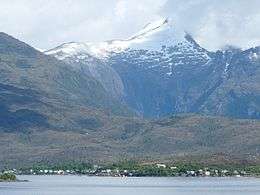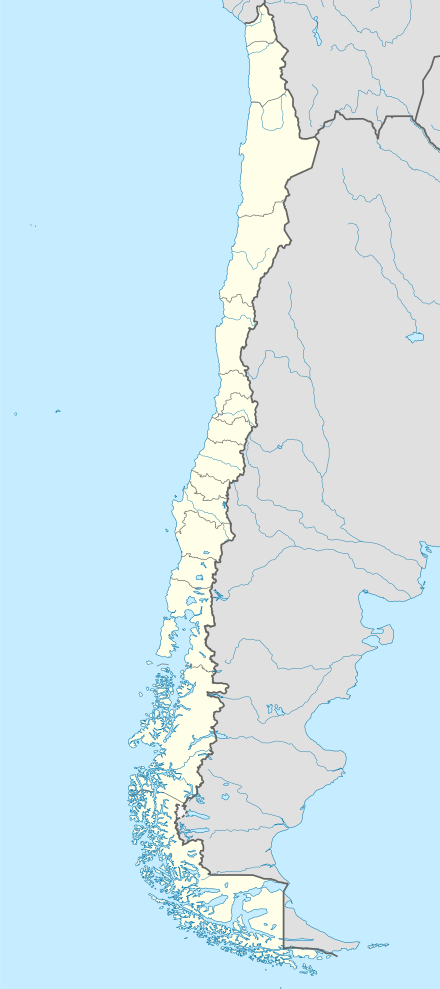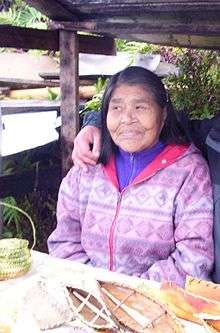Villa Puerto Edén
Villa Puerto Edén is a Chilean hamlet and minor port located in Wellington Island, in Natales commune, Última Esperanza Province, Magallanes Region. It is considered one of Chile's most isolated inhabited places together with Easter Island and Villa Las Estrellas. The village is known for being the home of the last Kawéshkar people. Owing to the large tidewater glaciers caused by the region’s super-high precipitation, it is only accessible by sea, on the Navimag ferry from Puerto Montt in the north, or Puerto Natales in the south. There is also a monthly boat from Caleta Tortel.[1]
Villa Puerto Edén Jetarktétqal (Kawésqar) | |
|---|---|
 | |
 Villa Puerto Edén | |
| Coordinates: 49.139°S 74.453°W | |
| Country | |
| Region | |
| Province | Última Esperanza |
| Commune | Natales |
| Government | |
| • Type | Municipalidad |
| • Mayor | Mario Margoni Gadler |
| Population | |
| • Total | 176 |
| Time zone | UTC−3 (CLST) |
| Area code(s) | Country + town = 56 + 61 |
The population is 176 (2002 census). Owing to the extraordinarily humid climate the village has no roads, with only pedestrian boardwalks connecting the houses and shops. A weekly transport boat takes local fish and shellfish products (the latter mainly mussels) to markets.
Climate
Villa Puerto Edén has an extremely wet subpolar oceanic climate (Köppen Cfc) and is widely reputed to be the place in the world with the highest frequency of rainfall,[2] though according to Guinness World Records the highest frequency of rain in a year occurred at Bahia Felix, a little further south, with only eighteen rainless days in the whole of 1916. The annual rainfall is almost exactly equal to that of Little Port Walter in the similarly wet Alaska Panhandle, but is more evenly spread across the year, with a minimum average monthly rainfall of 375 millimetres (14.8 in) as against 200 millimetres (7.9 in) in Little Port Walter.
| Climate data for Puerto Eden | |||||||||||||
|---|---|---|---|---|---|---|---|---|---|---|---|---|---|
| Month | Jan | Feb | Mar | Apr | May | Jun | Jul | Aug | Sep | Oct | Nov | Dec | Year |
| Average high °C (°F) | 14.7 (58.5) |
13.9 (57.0) |
12.4 (54.3) |
10.3 (50.5) |
7.5 (45.5) |
5.7 (42.3) |
5.5 (41.9) |
6.7 (44.1) |
8.1 (46.6) |
10.3 (50.5) |
12.3 (54.1) |
13.9 (57.0) |
10.1 (50.2) |
| Daily mean °C (°F) | 11.6 (52.9) |
10.8 (51.4) |
9.7 (49.5) |
7.4 (45.3) |
4.8 (40.6) |
3.3 (37.9) |
3 (37) |
3.9 (39.0) |
5.2 (41.4) |
6.5 (43.7) |
8.9 (48.0) |
10.8 (51.4) |
7.1 (44.8) |
| Average low °C (°F) | 8.4 (47.1) |
7.9 (46.2) |
6.8 (44.2) |
5 (41) |
3 (37) |
1.5 (34.7) |
0.8 (33.4) |
1.6 (34.9) |
2.7 (36.9) |
4.3 (39.7) |
6 (43) |
7.3 (45.1) |
4.6 (40.3) |
| Average precipitation mm (inches) | 507.5 (19.98) |
523.1 (20.59) |
532.2 (20.95) |
525.2 (20.68) |
508.7 (20.03) |
482.8 (19.01) |
499.7 (19.67) |
419.2 (16.50) |
377.9 (14.88) |
447.2 (17.61) |
456.7 (17.98) |
464.8 (18.30) |
5,745 (226.18) |
| Source: Meteorología Interactiva[3] | |||||||||||||
Gallery
- View of Villa Puerto Edén's docks
 Alacaluf woman
Alacaluf woman- Houses of Puerto Edén
 Street in Puerto Edén
Street in Puerto Edén- Harbour of Puerto Edén
See also
- Wettest places on Earth
- Puerto Edén Igneous and Metamorphic Complex

References
- South American Handbook 2009 ISBN 978-1-906098-36-0 p.857
- Lindenmayer, Clem; Trekking in the Patagonian Andes (Lonely Planet Walking Guide); pp. 17-31. ISBN 0-86442-477-9
- "Información climatológica de estaciones chilenas" (in Spanish). Archived from the original on December 9, 2012. Retrieved September 6, 2012.